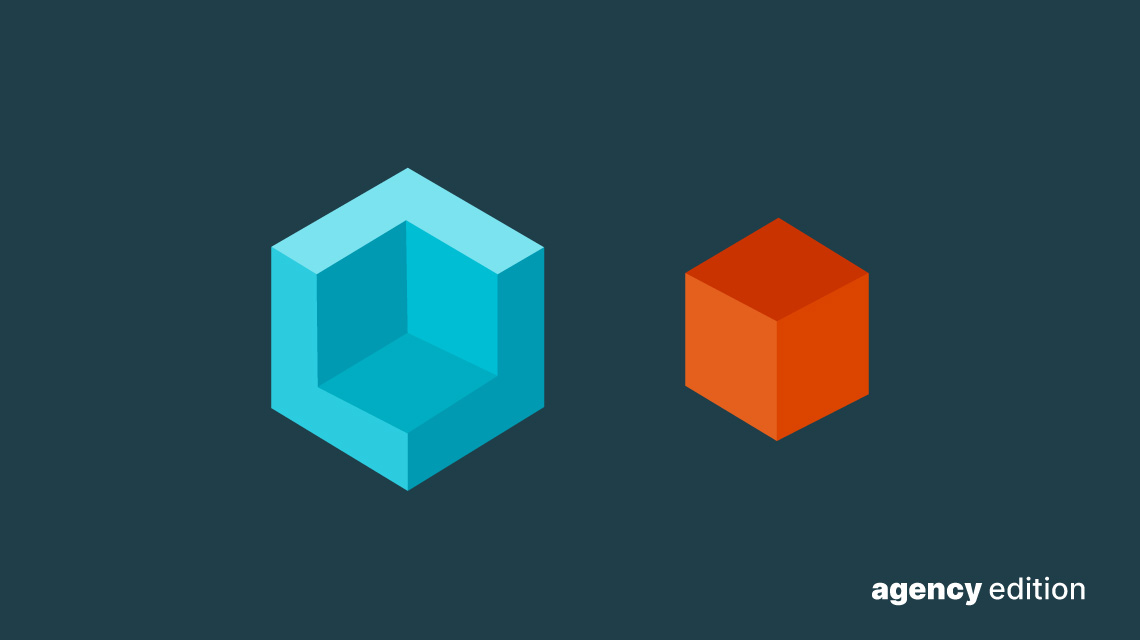
There’s nothing more satisfying than helping your clients outshine their competitors on social media.
To achieve this, you have to keep a close eye on what the competition is doing. You need to know what’s working for them, and how they are performing compared to your clients.
Not only does this allow you to benchmark your social media performance, but it gives you the tools to improve your strategy.
In this article, we’ll explain everything agencies need to know about social media competitive analysis, from social media data collection tools and methods to drawing conclusions and presenting your findings. We also provide some examples of metrics to compare.
If you want better results from your competitor analysis, learn how to use quintly, a powerful tool for social media competitive analysis and benchmarking.
What is a competitive analysis on social media?
A social media competitive analysis is the process of identifying your closest competitors and gathering as much data as you can about their social media strategy and results.
You’ll look at key metrics like follower count, interactions, and reach across multiple channels, taking note of their successes and what kind of content gets the most positive engagement.
Then, you use this data as a benchmark to compare with your clients’ results and find ways to improve them.
What is the main goal of conducting a social media competitor analysis?
The goal of conducting a social media competitor analysis is to understand how well your clients are performing, what competitors are doing right and wrong, and how you can achieve better results.
Throughout the process, you’ll be able to:
- Identify and test new strategies that have worked well for others. For example, you might notice that the competitors’ audience responds well to humor and decide to try a similar approach.
- Avoid mistakes other brands have made. If another brand shared a tone-deaf post in response to a trending news topic, you won’t make the same mistake.
- Spot industry-wide trends. This helps you understand the context behind your client’s social performance.
- Uncover underused tactics that you can take advantage of. If your competitors are not very active on a channel that’s popular with your audience, you have a chance to grab a share of their attention on that channel.
By doing a competitive analysis, you’ll understand what kind of content your audience enjoys, so you can create more of it. You’ll identify gaps in the market, keep up with trends, and make sure your clients stay ahead of the competition.
Steps to running a competitive analysis
There are many different ways to conduct a social media competitive analysis. How you approach it will depend on your clients' goals and needs, and which channels they want to focus on.
However, you can use the following step-by-step guide as a template or starting point.
Step 1: Identify your competitors
Your clients may think they know exactly who their rivals are. However, their ideas may not be accurate. It’s important for agencies to do their own research to ensure they are comparing like for like.
When deciding which companies to include in your competitive analysis, look for brands that:
- Rank high on Google and in social media searches for your client’s target keywords.
- Serve the same audience. Their target customer should have similar characteristics, desires, pain points, and behaviors as your client’s.
- Are active on social media. You want to learn from the best, so look for brands that put effort into social media and have a successful strategy in place.
Search on Google or social media sites to find potential competitors, and browse their profiles with the above criteria in mind. Try also searching ranking sites with specific criteria, for example, best agencies in London, or industry-specific directories, for example, top hospitality marketing agencies.
You should aim to identify between three and five highly relevant companies that are doing great on social media. These are the brands you want to learn from - and eventually, beat.
Step 2: Collect social media data
The next stage in the process is collecting social media data. There are two approaches you can take.
Firstly, you can collect social media data manually. Visit all the social media profiles of your chosen brands and take note of their follower count, likes per post, interactions, shares, and more.
Many social media platforms have native analytics tools that can help you scrape data about your competitors, such as Facebook Insights and Twitter Analytics.
However, this approach is time-consuming and inefficient because you have to visit each social media channel separately and enter all the data into a spreadsheet.
The information will never be completely up-to-date, as follower counts and likes change constantly. What’s more, it’s much harder to draw comparisons between different channels and calculate complex metrics.
The second option is to automate your social media data collection. Tools like quintly provide a way to collect public data from your competitors’ social media profiles and bring it all together in one place.
This way, you can get accurate, complete, and timely data that will allow you to get meaningful comparative insights from your social media competitive analysis.
All you have to do is add the company profiles you want to track. You can use quintly’s competitive benchmarking dashboards to see accurate, up-to-date information, all in one place.
quintly also “cleans” the data you collect. This means that data from different channels is converted to a standardized format that can be easily compared.
You can create custom dashboards and track a wide variety of metrics that can also be customized or created from scratch to suit your clients’ needs.
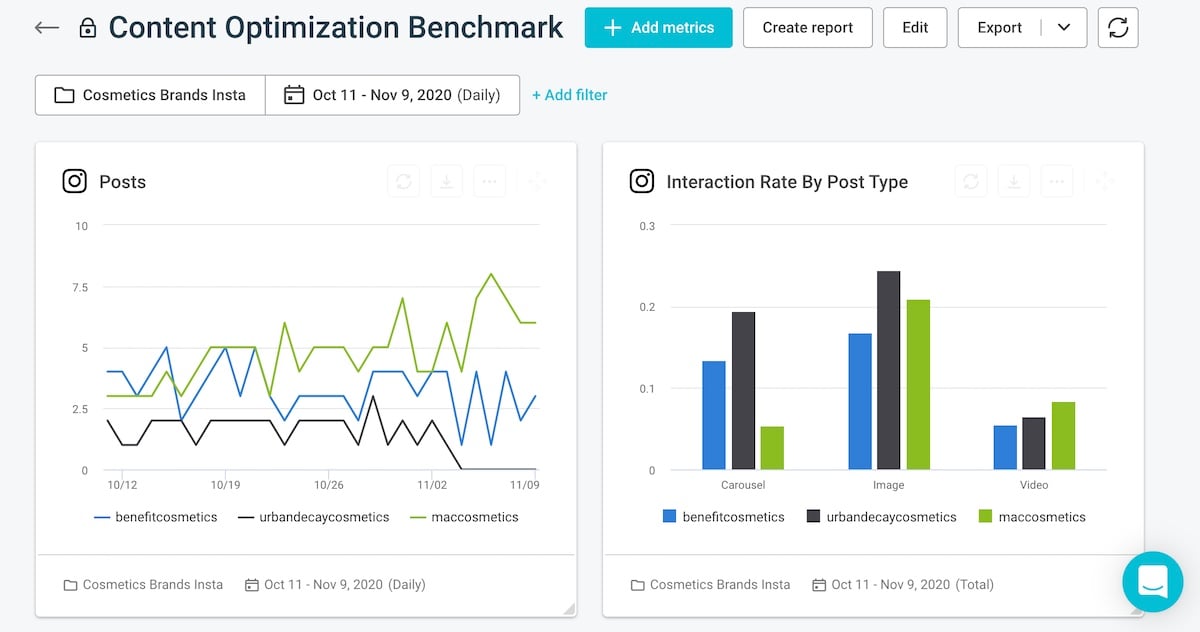
3. Analyze social media data
Once you’ve gathered plenty of data about your clients’ competitors, you need to start drawing conclusions from your findings.
Of course, you won’t know all the exact motivations behind what these brands are doing. So you’ll have to use your data to make educated guesses about what they are trying to do.
At this point, you may need to explore their social profiles, looking at what type of content they post, and when and where they are most active.
It’s a good idea to use the SWOT framework to pinpoint the Strengths and Weaknesses in your strategy, as well as Opportunities and potential Threats.
4. Present your competitive analysis to your clients
Finally, you need to present your findings to your clients in a way that’s easy for them to understand. You should back up your conclusions with evidence and create a plan of action based on what you’ve learned.
With quintly, you can generate social media reports based on your competitor analysis.
Just go to your dashboard, and click on “Create Report.” You’ll then be able to adjust your settings and export the report into a variety of formats, including an interactive link that clients can explore on their own.
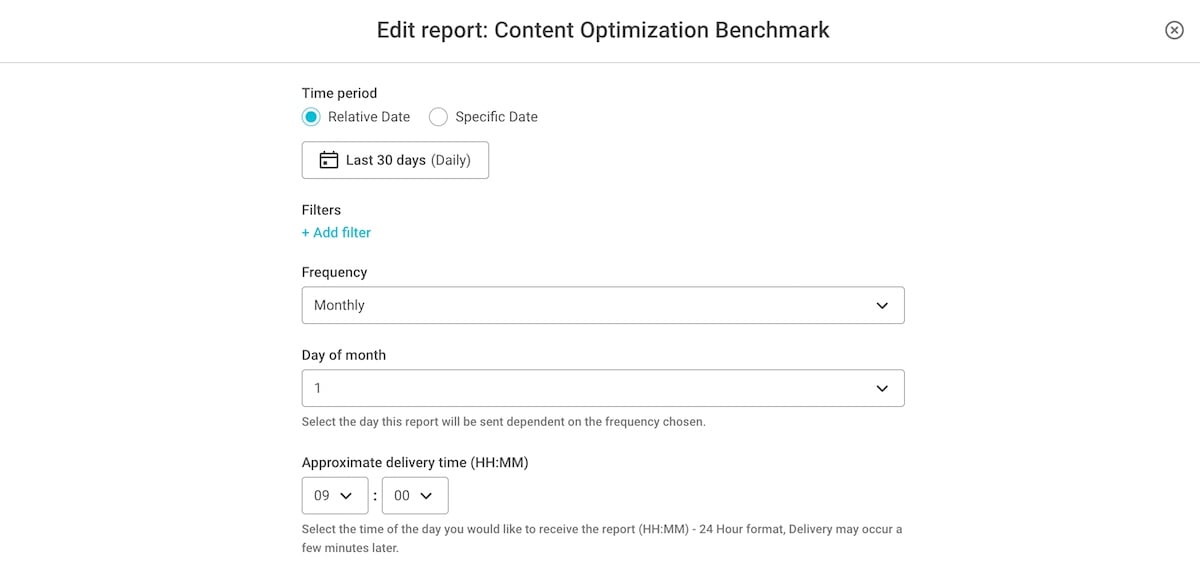
Social media competitive analysis examples
You may be wondering about the kind of metrics you should compare in a social media competitive analysis, and what conclusions you can draw from your findings.
Usually, the metrics you track will depend on your client’s social media KPIs. Here are a few examples of metrics to measure social media performance across different channels.
Social media competitive analysis: Instagram
As an image-based platform, Instagram is a favorite with beauty brands. It’s a great tool for them to showcase their products and repost user-generated content, like selfies from beauty bloggers and makeup artists.
Since Halloween is an especially busy time for makeup brands, we decided to run a competitive analysis on Instagram covering the two weeks leading up to the height of the spooky season. We picked 6 top beauty brands – NYX, Too Faced, Urban Decay, Benefit, Tarte and Ulta Beauty – as our competitive set.
The table below from quintly shows all the key information we need to know about each brand’s social media performance to be able to compare them. We have sorted the list by follower count, in descending order.
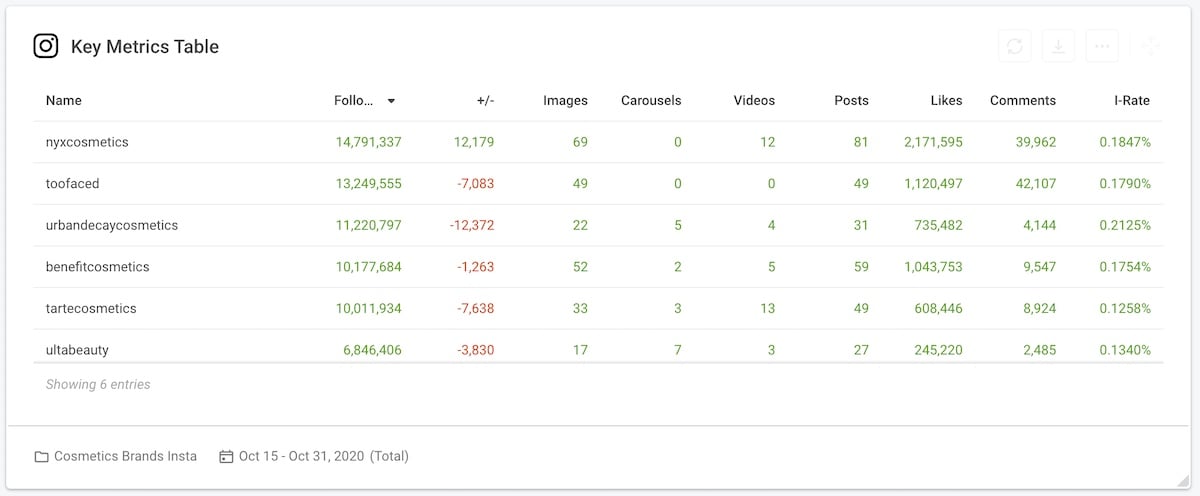
As you can see, NYX Cosmetics leads the way in terms of follower count, and its following is growing steadily.
However, what sticks out from the graph below is the huge peak in Followers Change Rate for Too Faced. If your client were a beauty brand competing against Too Faced, you would want to look into what they posted on that specific day that earned them so many new followers.
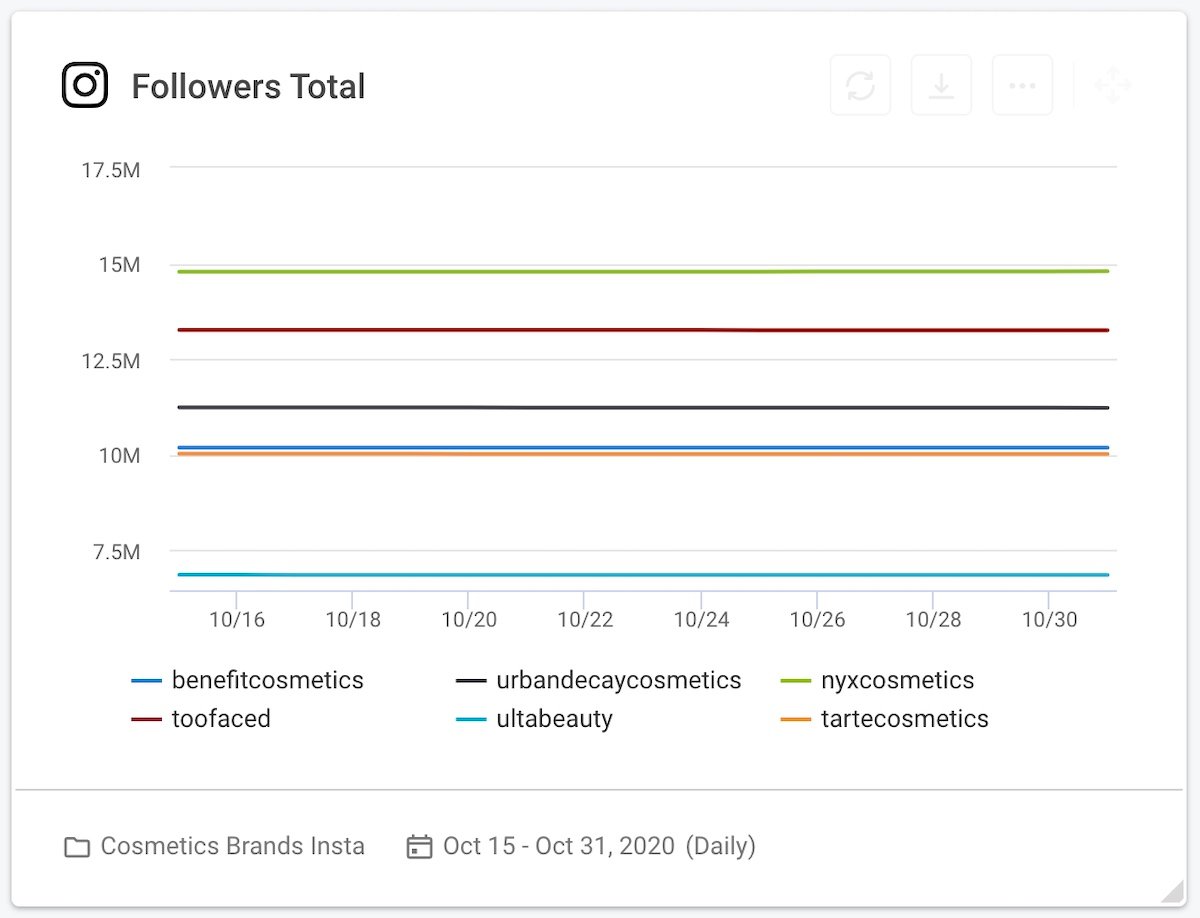
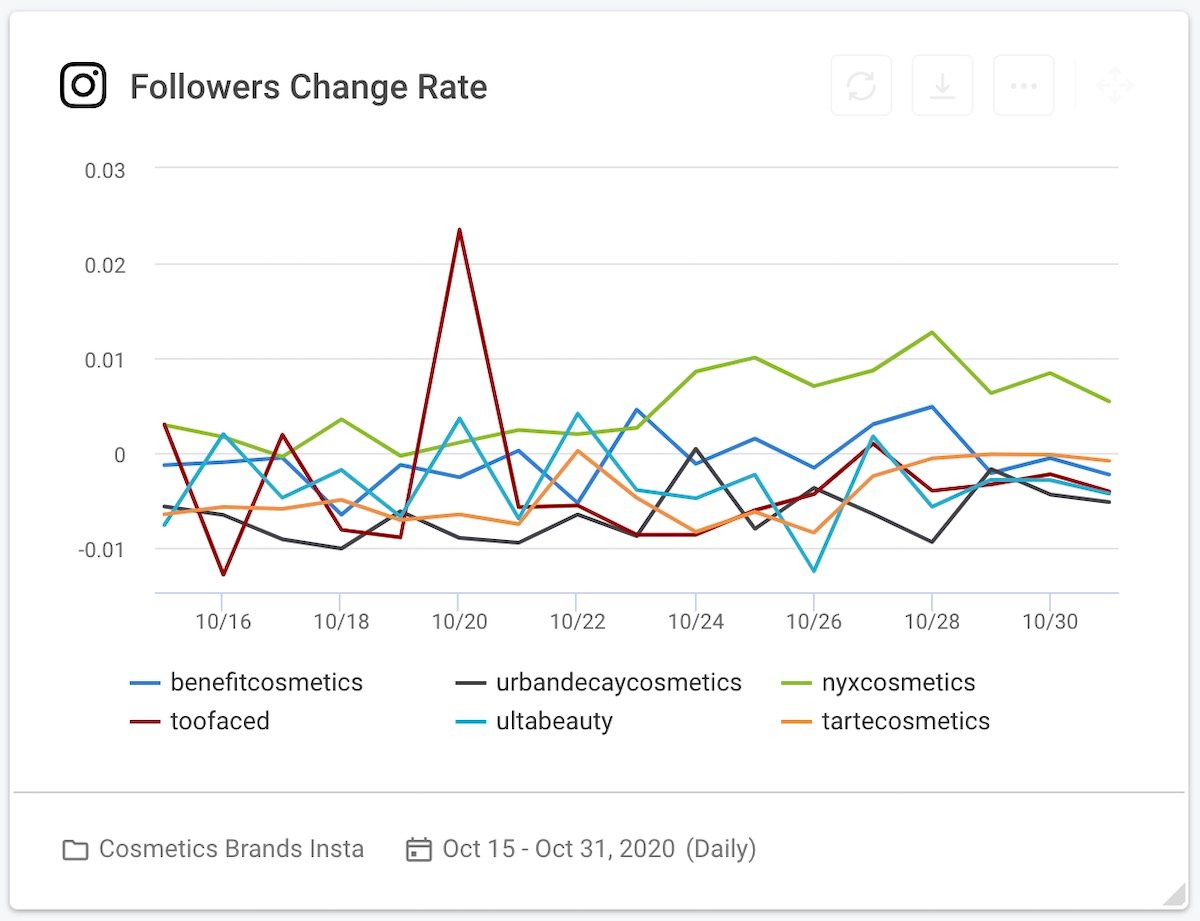
Observing the Posts graph in quintly, we can see that NYX Cosmetics was the most active on Instagram in this period of two weeks, often posting 6 times a day and sharing as many as 8 posts on Halloween.
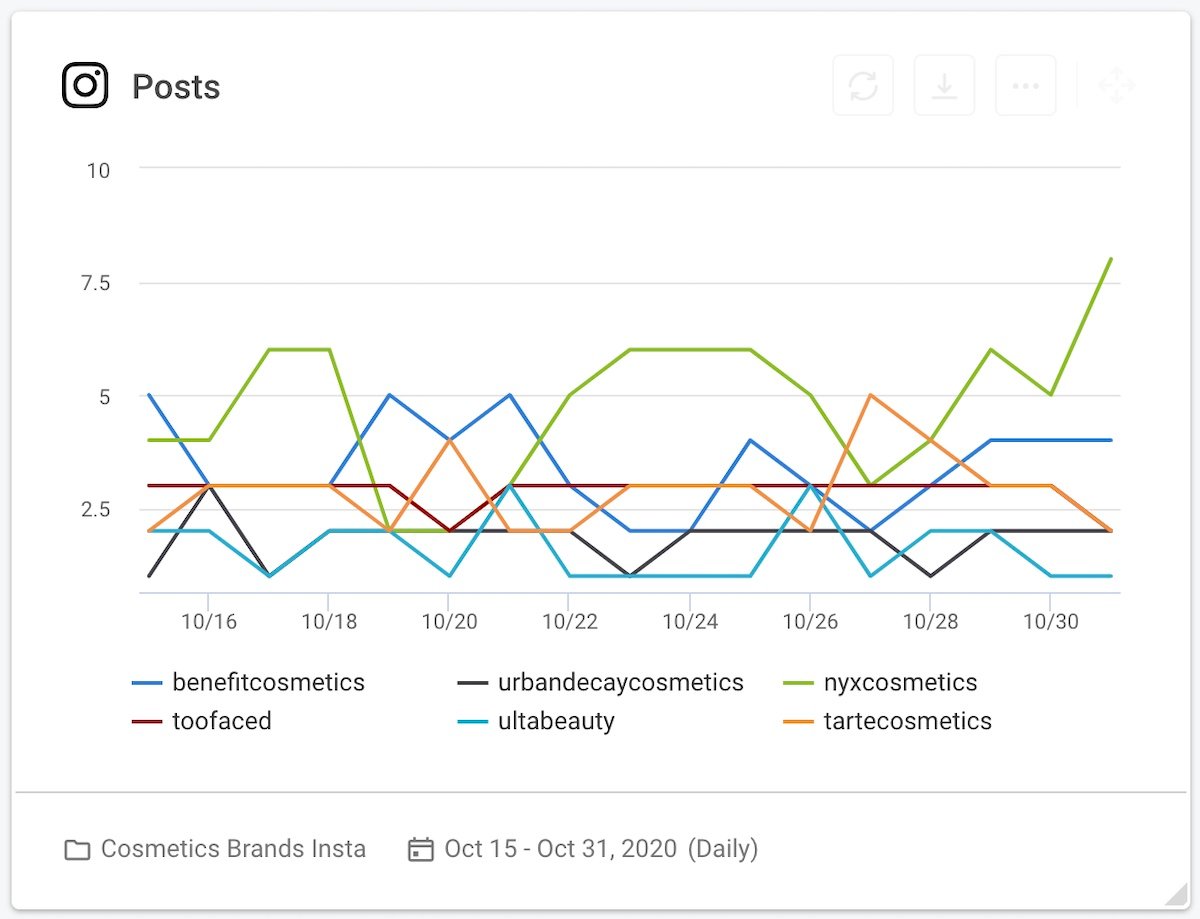
So when we look at the Total Interactions these brands received in our selected period, it’s no surprise that NYX Cosmetics takes the crown. However, it’s interesting to see Benefit Cosmetics coming in third.
Benefit Cosmetics has over 3 million fewer followers than its rival Too Faced, and yet it managed to garner an almost equal number of interactions. It also has 1 million fewer followers than Urban Decay Cosmetics, and still surpassed it in Total Interactions.
This is because Benefit Cosmetics posted more frequently in the two-week period (59 posts versus 49 and 31 for Too Faced and Urban Decay respectively, as seen in the key metrics table above). It could also be because Benefit’s followers are more engaged.
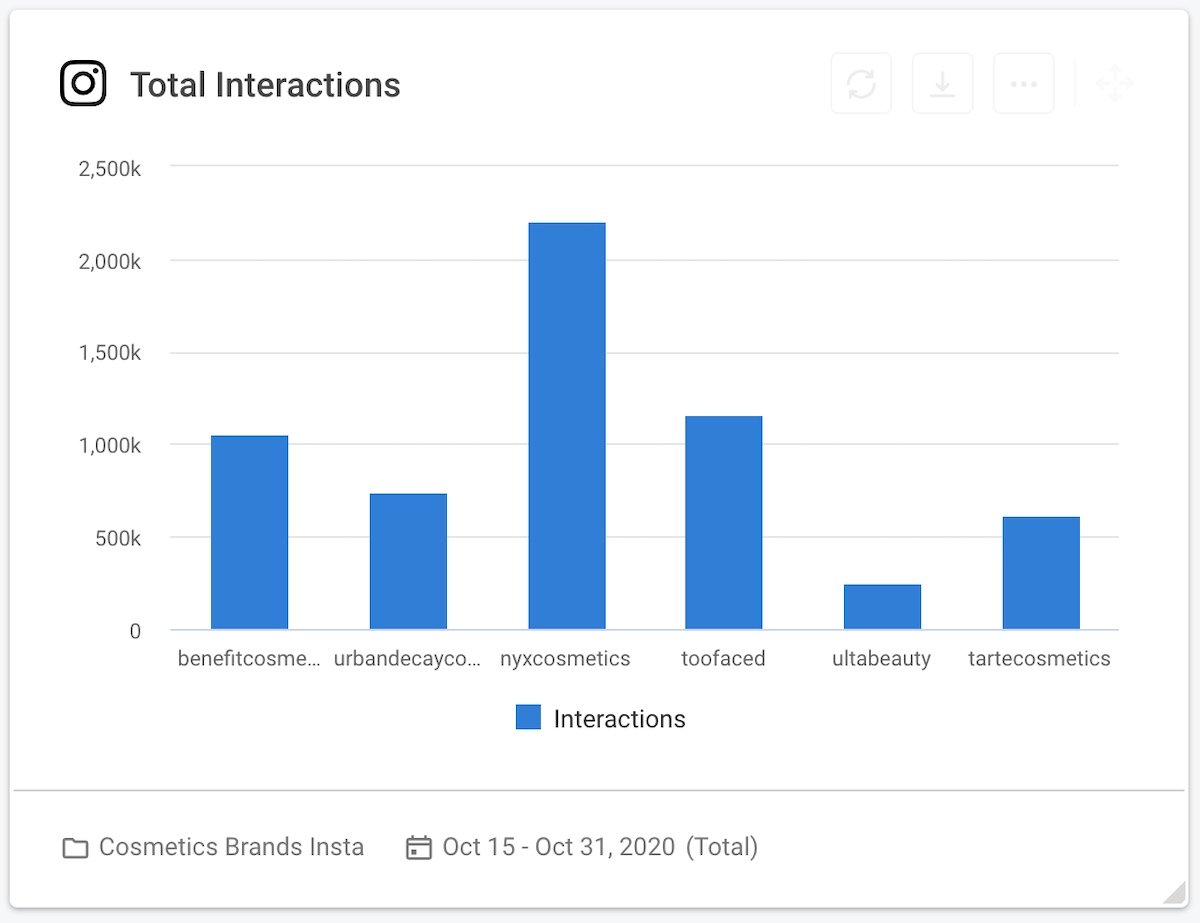
Looking at the Average Interactions Per Post, we see two spikes in interactions that indicate successful campaigns by Too Faced and Urban Decay Cosmetics.
Since we’re analyzing a holiday season when brands often run special campaigns, it’s likely that both these peaks are due to a sale, a competition or a giveaway.
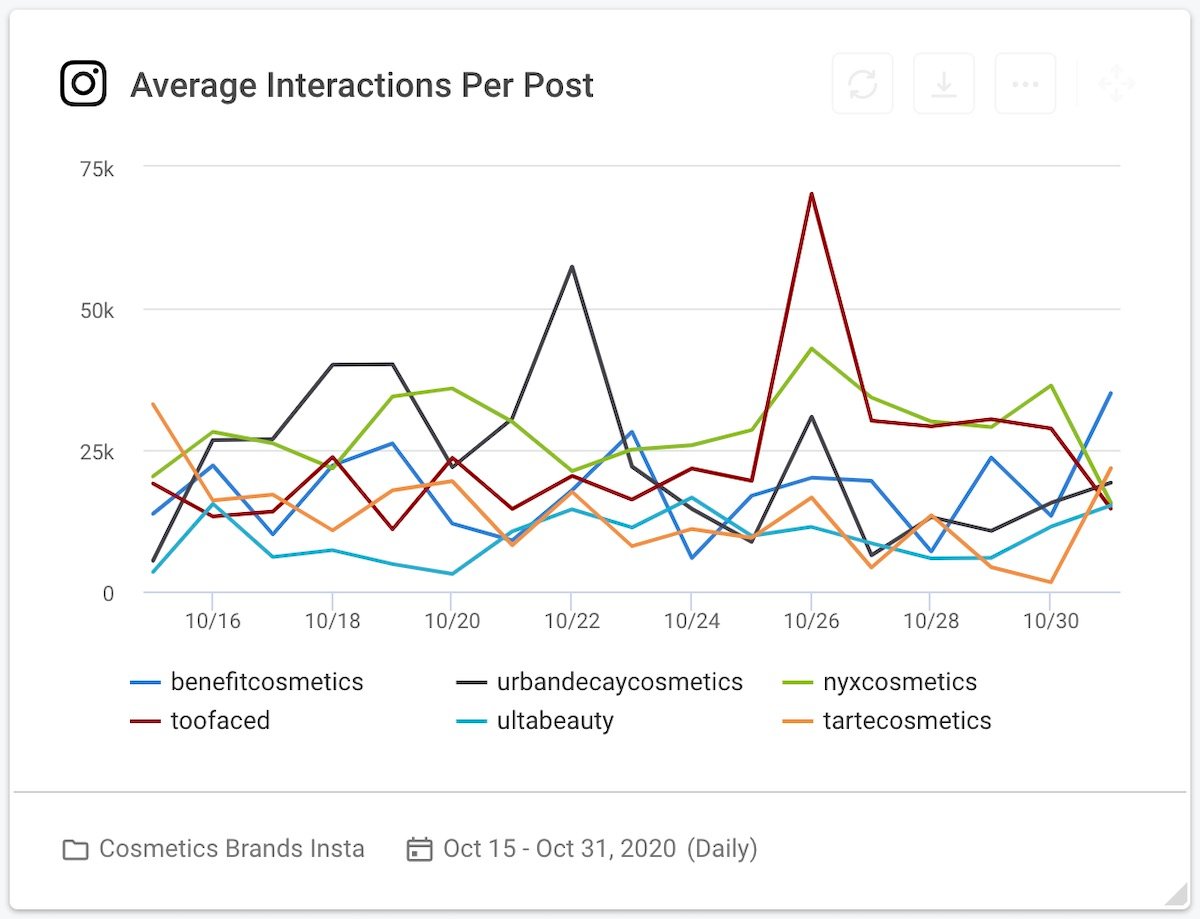
Sure enough, scanning the Posts Table reveals that the most liked (and most commented on) post was a Halloween giveaway by Too Faced. Interestingly, it’s followed by a simple gamified post by Benefit Cosmetics, with Urban Decay’s pre-Black Friday 50% sale coming in third.
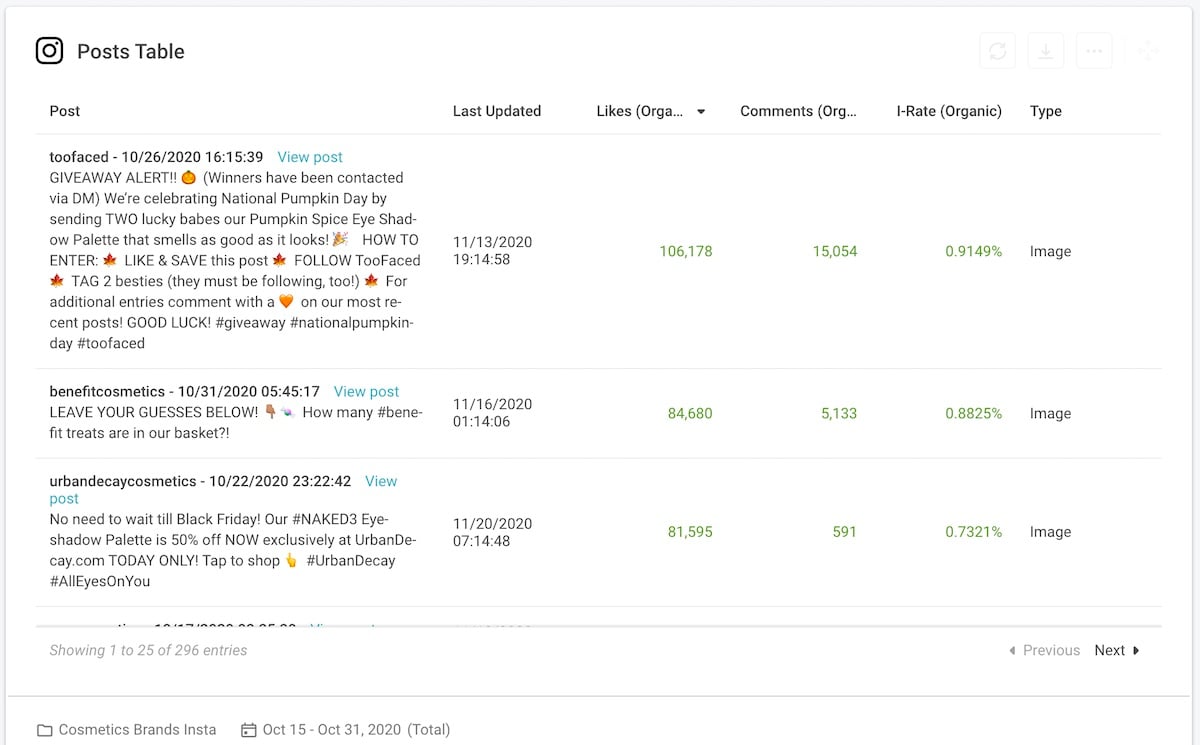
Running a competitive analysis in a similar way can help you discover the tactics that your competitors are using to grow their following and increase their engagement. Once you’ve seen what works and what doesn’t, you can give actionable advice to your clients on how to prepare for their next campaign.
Also read: 10 Tips for Better Interaction on Instagram
Social media competitive analysis: Facebook
If Facebook is a key channel for your client, you’ll want to analyze how they measure up to their competitors on the platform.
In quintly, you can find ready-made dashboards that allow you to compare social media profiles, and add as many prebuilt or custom metrics as you’d like.
To demonstrate, let’s compare two of the world’s most famous car brands on Facebook: BMW and Mercedes-Benz.
The Key Metrics Radar is a handy graph that lets you see where you stand compared to your competitors at a glance.
Here’s what it tells us about the two-car brands:
- BMW and Mercedes-Benz have almost the same number of Fans on Facebook.
- BMW leads in terms of Fans Change Rate, meaning that its following is growing faster than Mercedes-Benz’s.
- Mercedes-Benz was much more active on Facebook in the two-week period we’re analyzing (see Own Posts). However, BMW had a much higher Interaction Rate, meaning that even though it posted less, its individual posts garnered more attention.
- Overall, Mercedes-Benz leads in terms of Total Interactions and Response Rate, which is important for customer service.
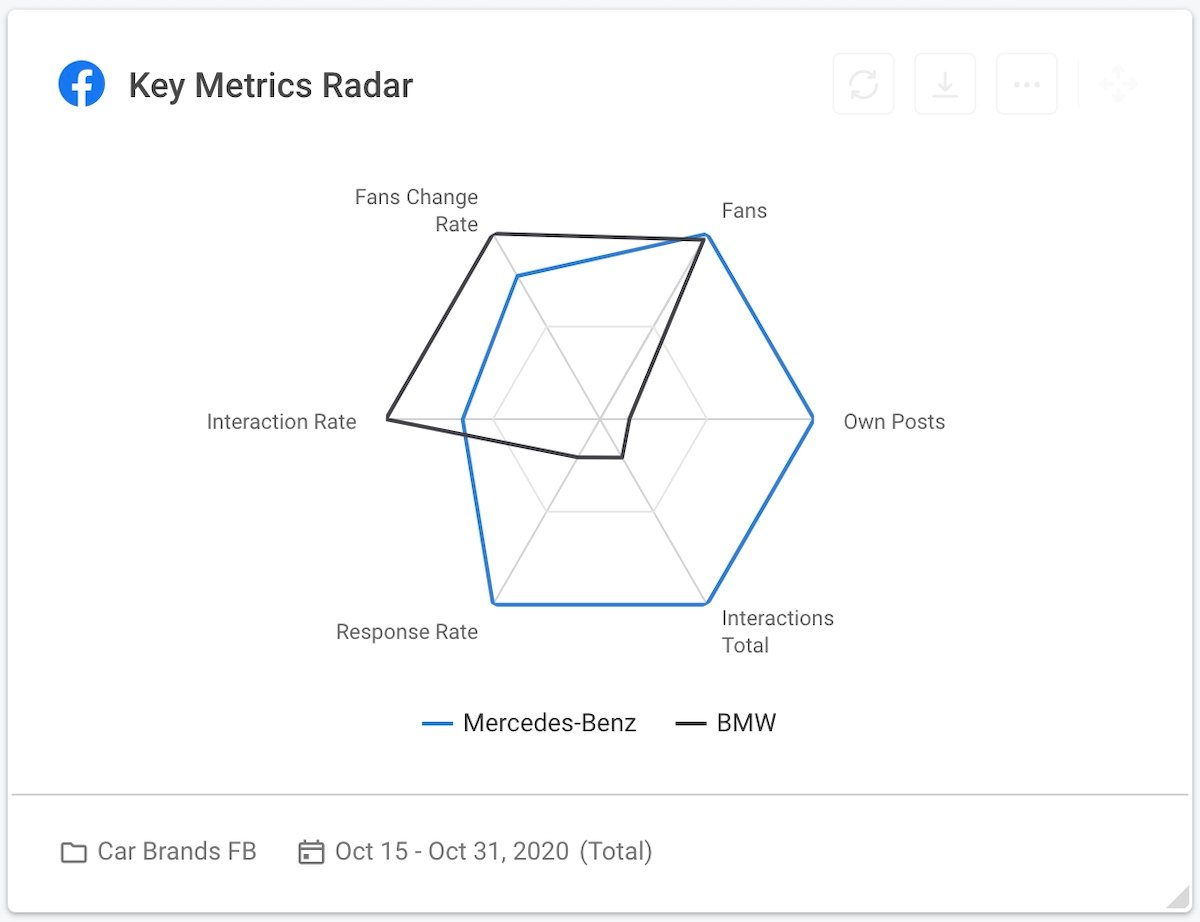
Of course, this is just an overview. If you wanted to dig deeper and see exact numbers, you’d look at graphs like Own Posts and Interaction Rate.
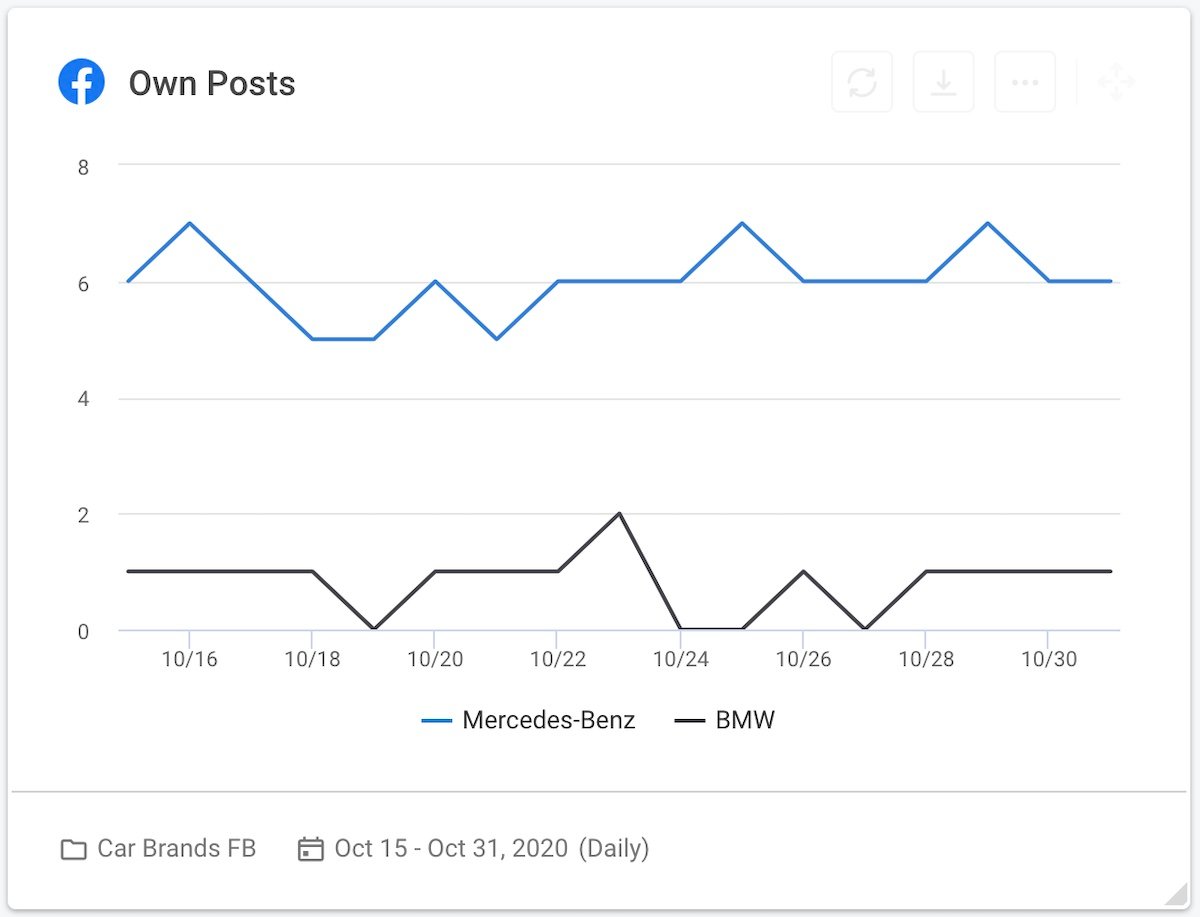
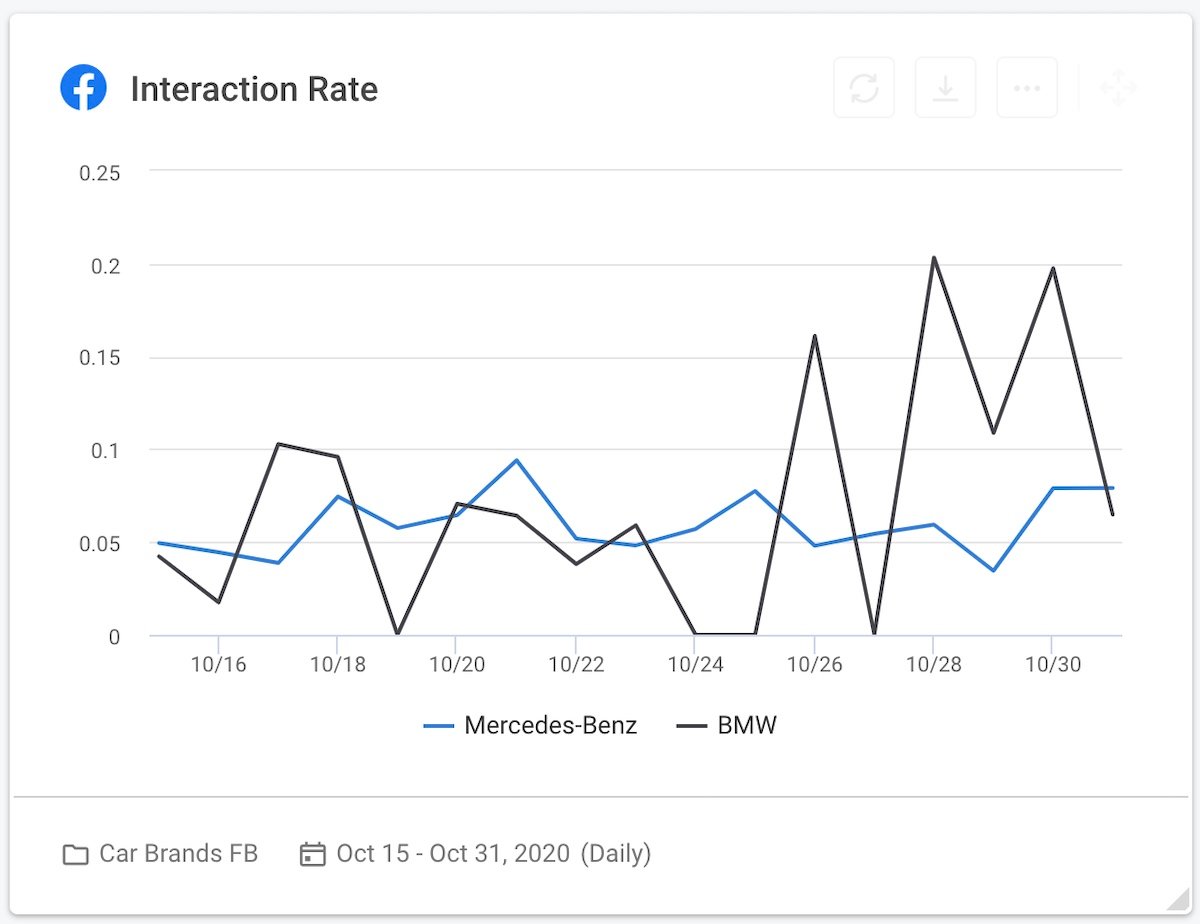
To discover which posts earned such a high Interaction Rate for BMW, let’s look at the Own Posts table.
As you can see, both brands are head-to-head when it comes to the Total Interactions on the top posts of this period. But ultimately, BMW takes the race. If your client was Mercedes-Benz, you would want to carefully scrutinize the top 2 posts by BMW, and see what tactics the company used in terms of image, description, timing, hashtags, etc.
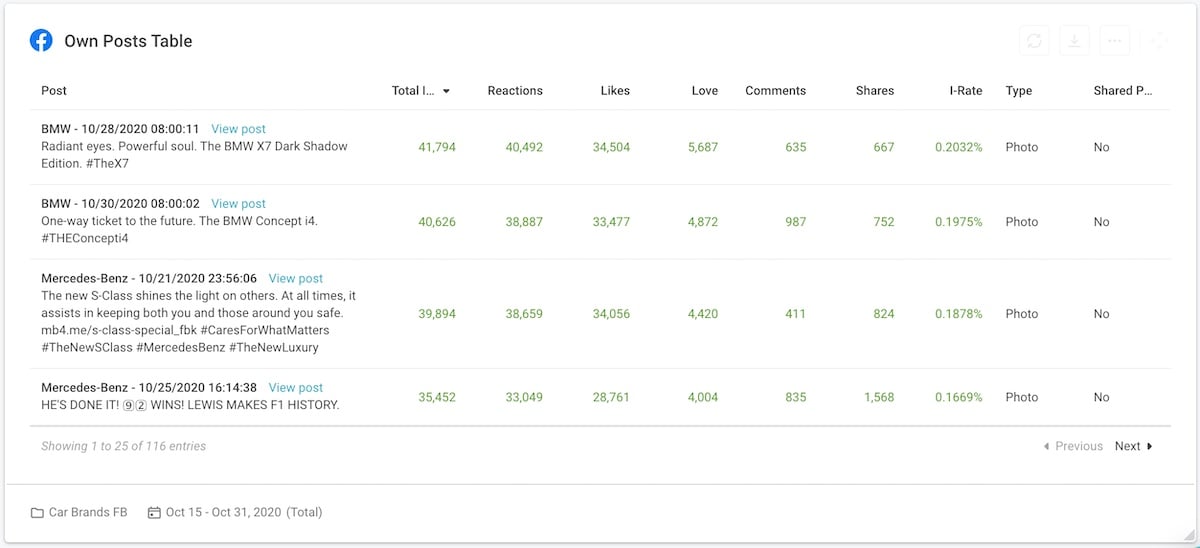
Social media competitive analysis: YouTube
For our YouTube competitive analysis example, let’s stick with the same beloved car brands.
Since YouTube has a 30-day data limit, we’re going to look at a period that’s closer to the writing of this blog post: the first two weeks of November.
The Key Metrics table tells us that Mercedes-Benz is far more active on YouTube than BMW.
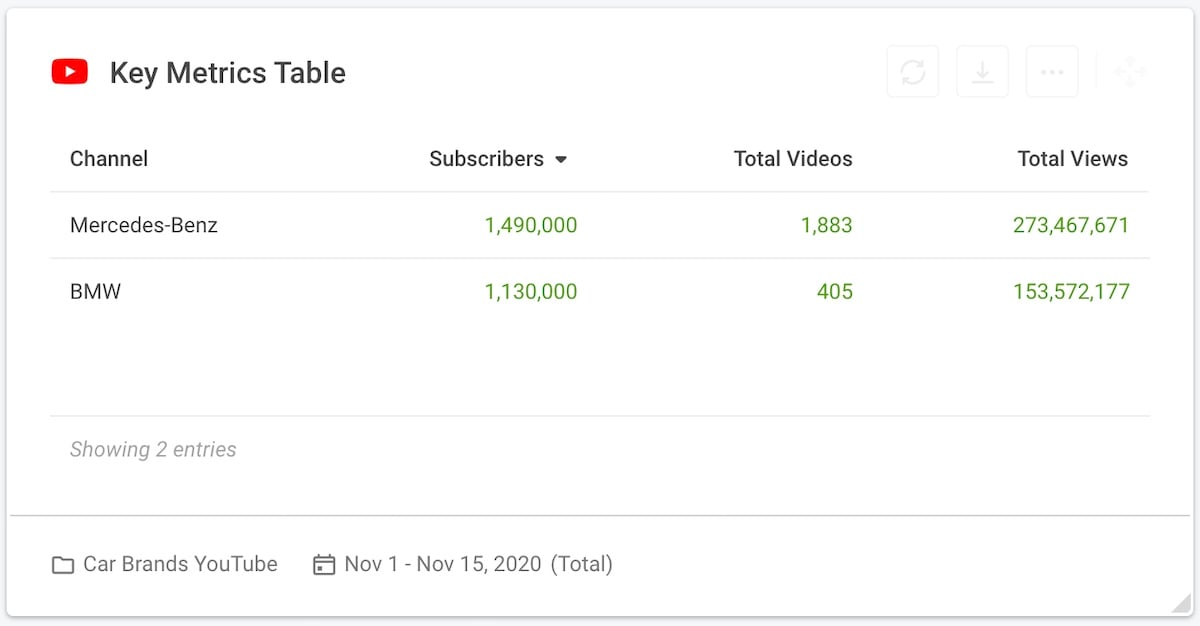
However, interestingly, the top 4 most-viewed videos of this period are from BMW. This is a similar pattern to what we saw on Facebook. BMW may post less but its posts seem to attract more attention from fans.
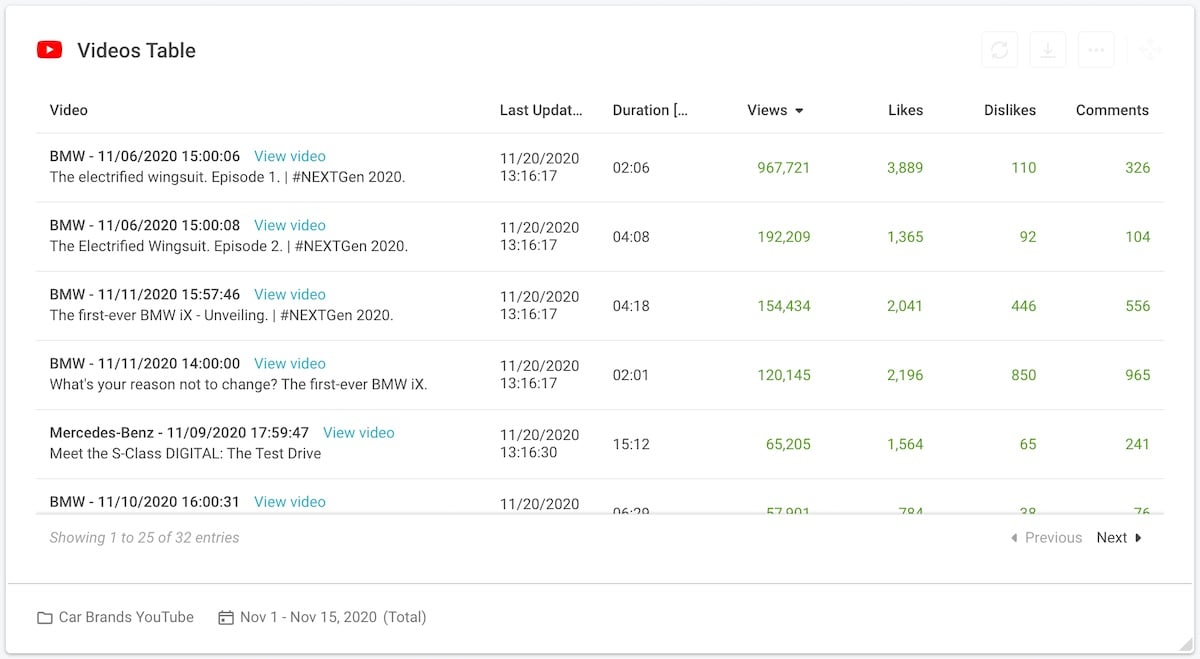
Of course, Mercedes-Benz still leads in Total Video Views. But the company would probably do well to research how BMW distributes its content to get a relatively high level of attention for the few videos it releases.
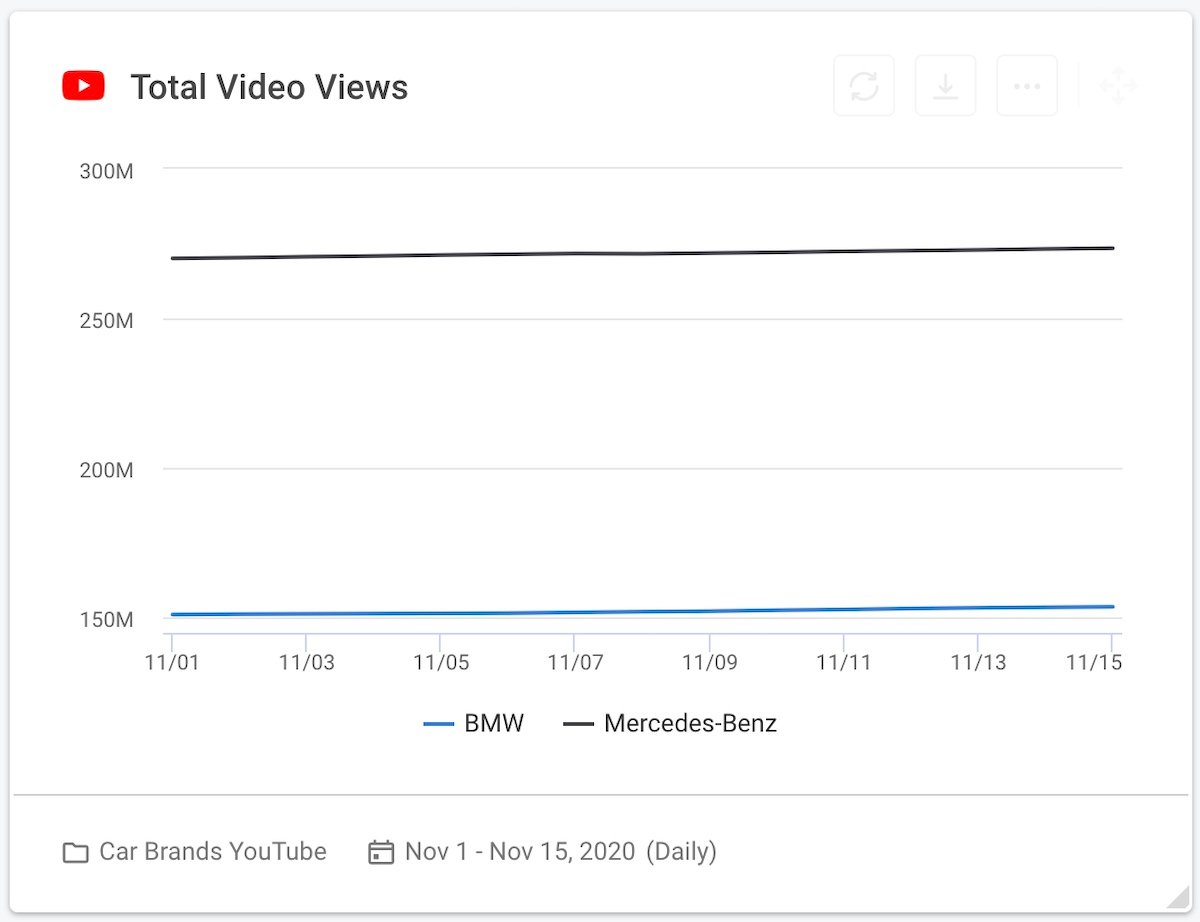
Social media competitive analysis: Twitter
Now, let’s have a look at Twitter. For this example, we chose three popular fast-food chains: Wendy’s, Taco Bell and Chipotle.
Burger chain Wendy’s has almost 4 million followers – considerably more than rivals Taco Bell or Chipotle. However, the second graph reveals an interesting spike in Chipotle’s followers over the course of 3 days.
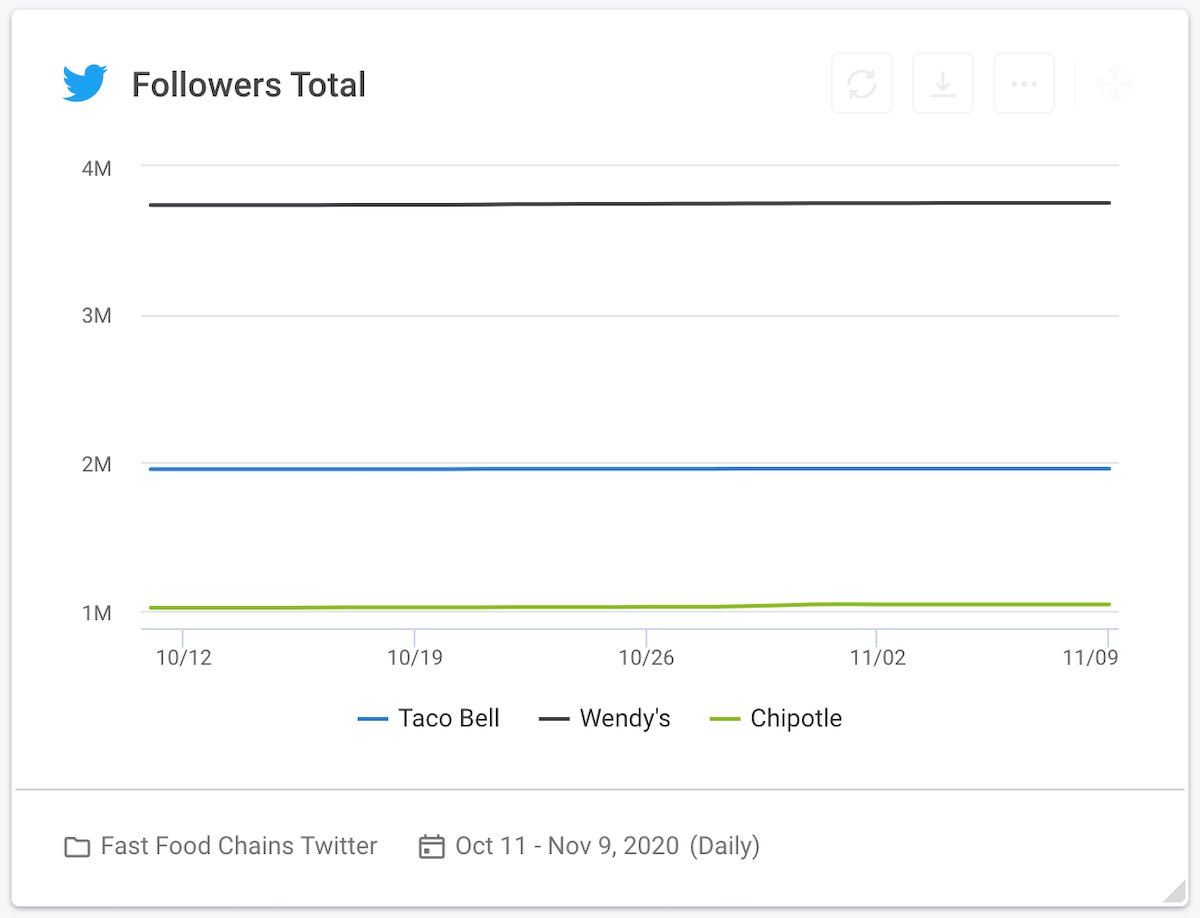
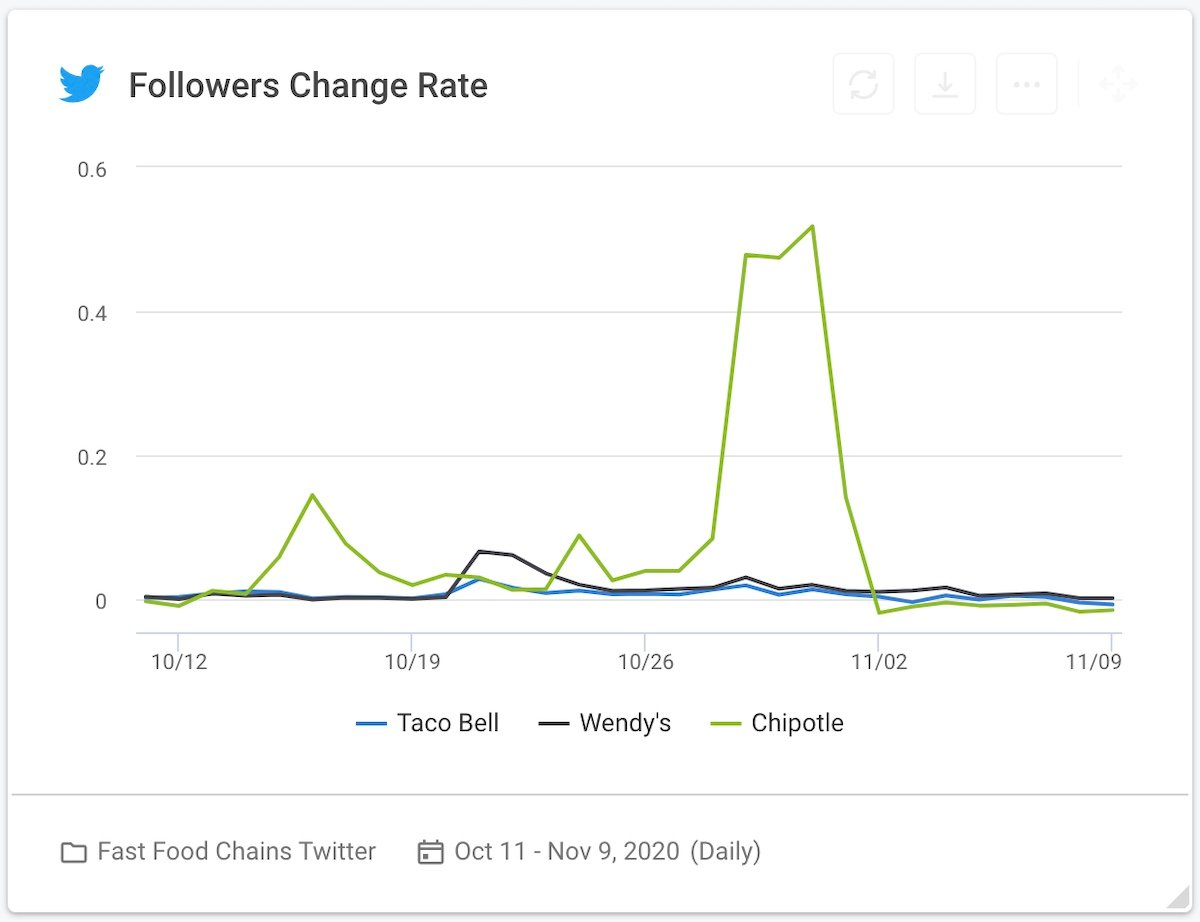
Based on this data, you’d probably want to find out what Chipotle was posting about in those three days to see if a similar tactic could work for you. Maybe one of its posts went viral! So let’s dig deeper.
The table below shows us Chipotle’s most retweeted tweet during those three days. Of course, a Halloween contest! Maybe that’s a tactic you should remember for your client’s next Halloween campaign.
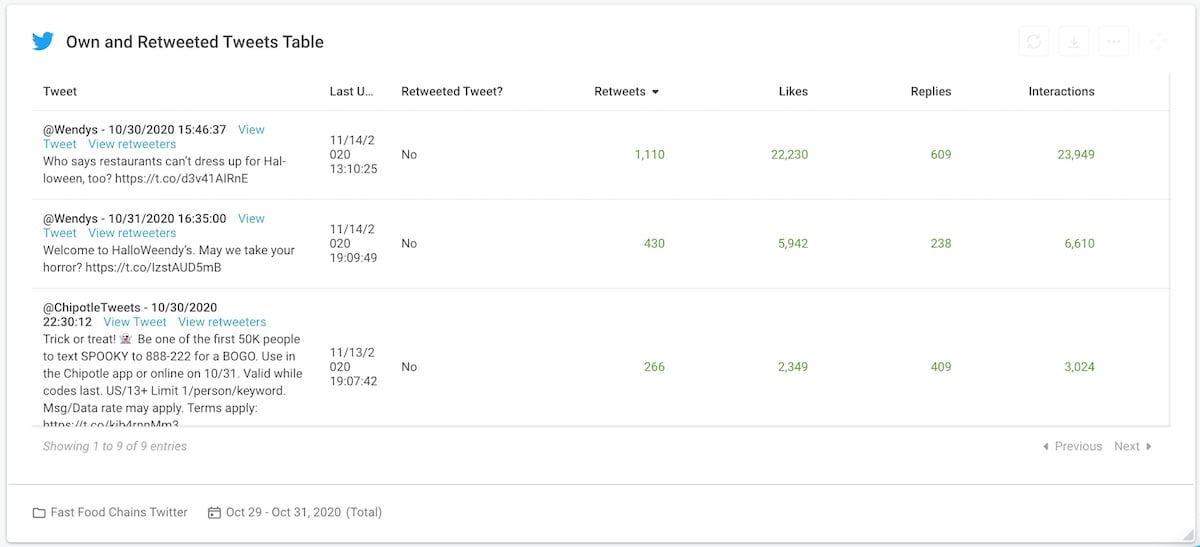
While Chipotle stole the show on Halloween, overall, Wendy’s has a higher percentage of interactions. This tells us its content is consistently engaging.
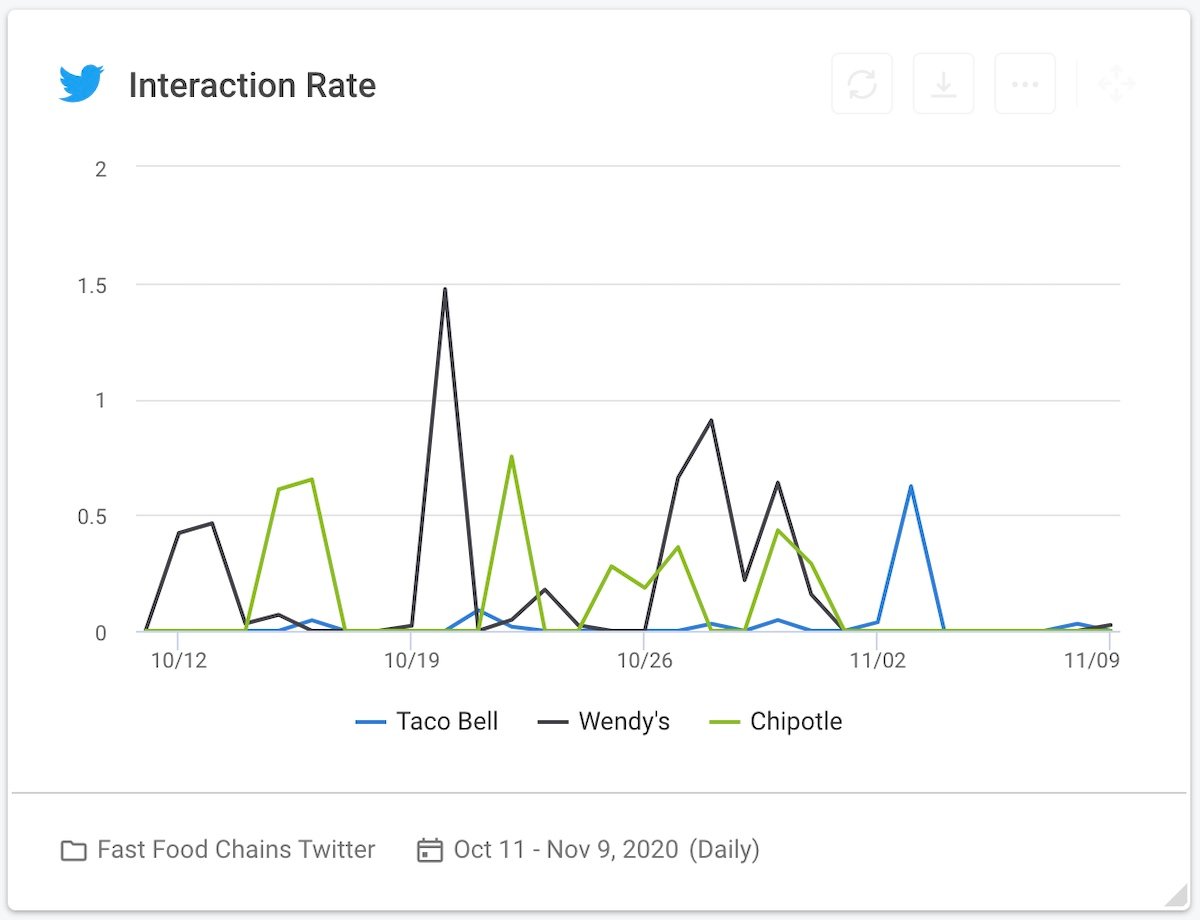
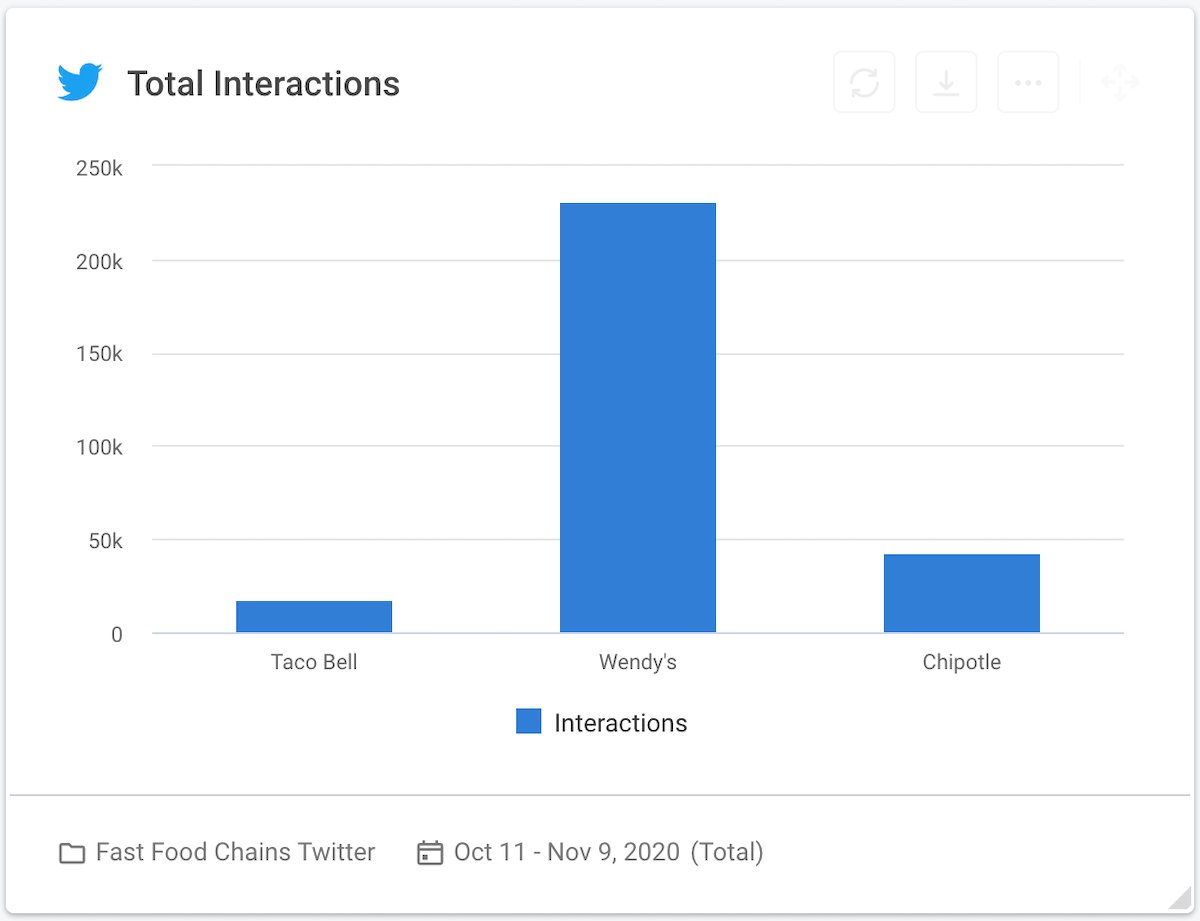
Social media competitive analysis: LinkedIn
Finally, for LinkedIn, let’s compare two US retail giants: Walmart and Target.
Walmart is clearly leading on this particular channel, as we can see in the chart below.
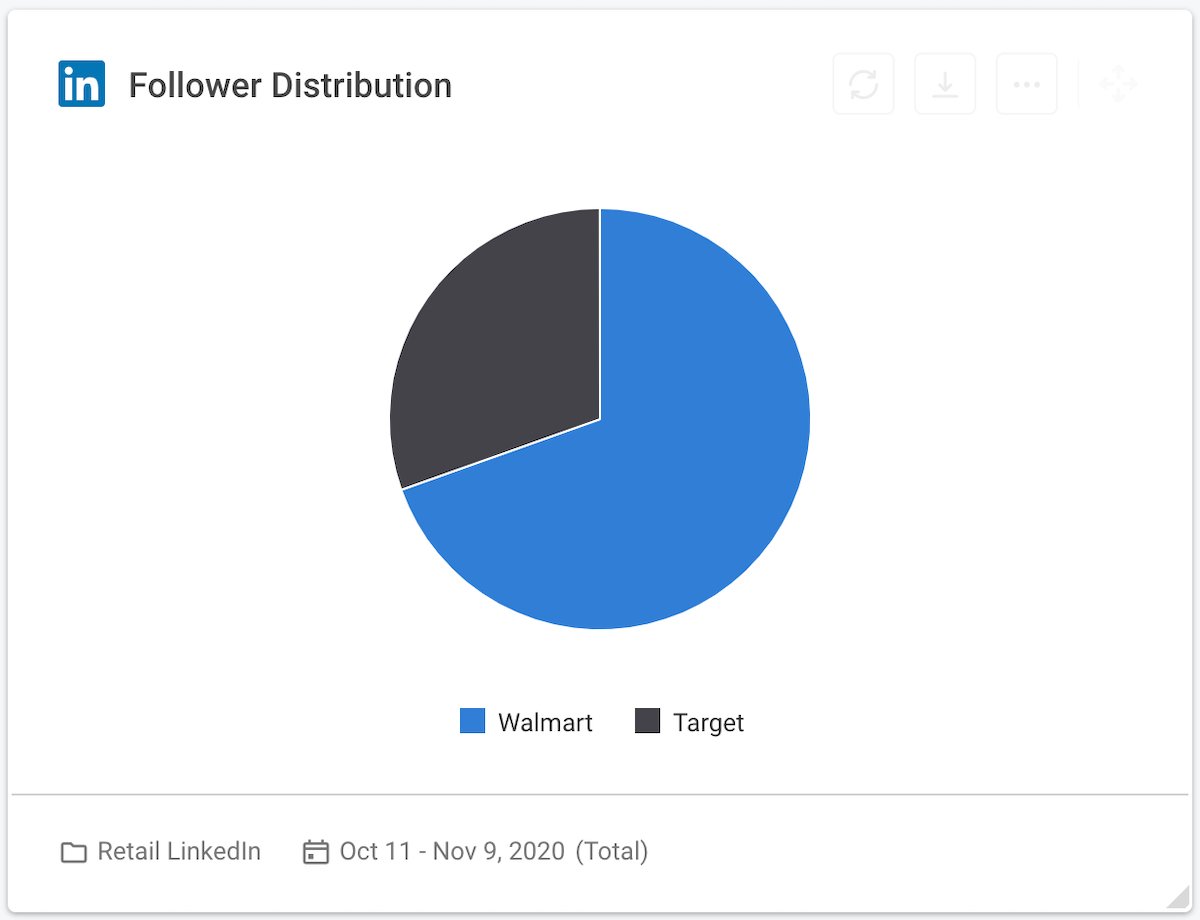
Walmart’s following is also growing at a faster pace. It dips slightly on weekends, which makes sense because LinkedIn is a professional platform that gets more traffic on weekdays.
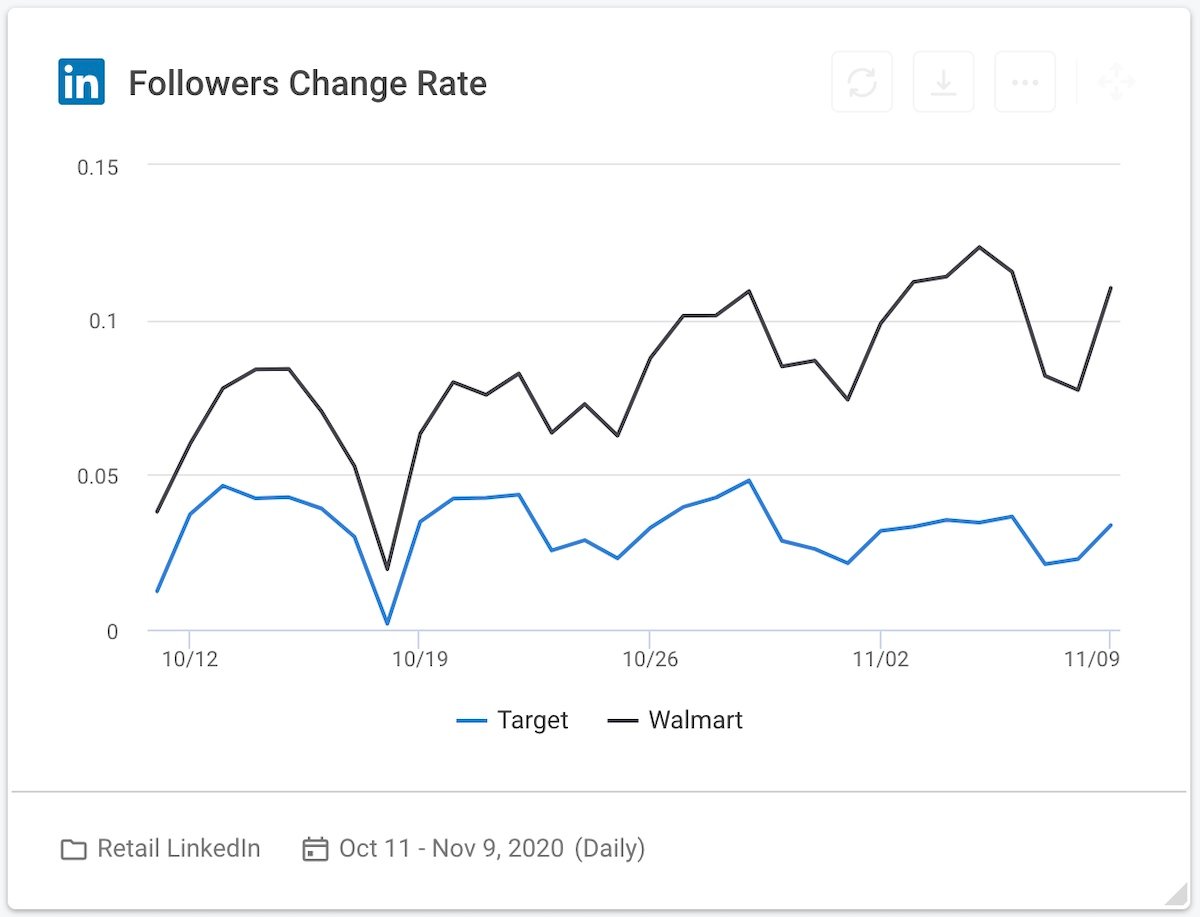
However, we can see that the change in followers over time reveals a pattern. This might indicate trends on LinkedIn itself, or that the two companies have tried similar tactics - and got similar results.
When we look at Followers Change Per Weekday, we can see that Monday through Wednesday are peak days for Walmart. So, maybe Target should aim to post new job opportunities and other types of content on those days, too.
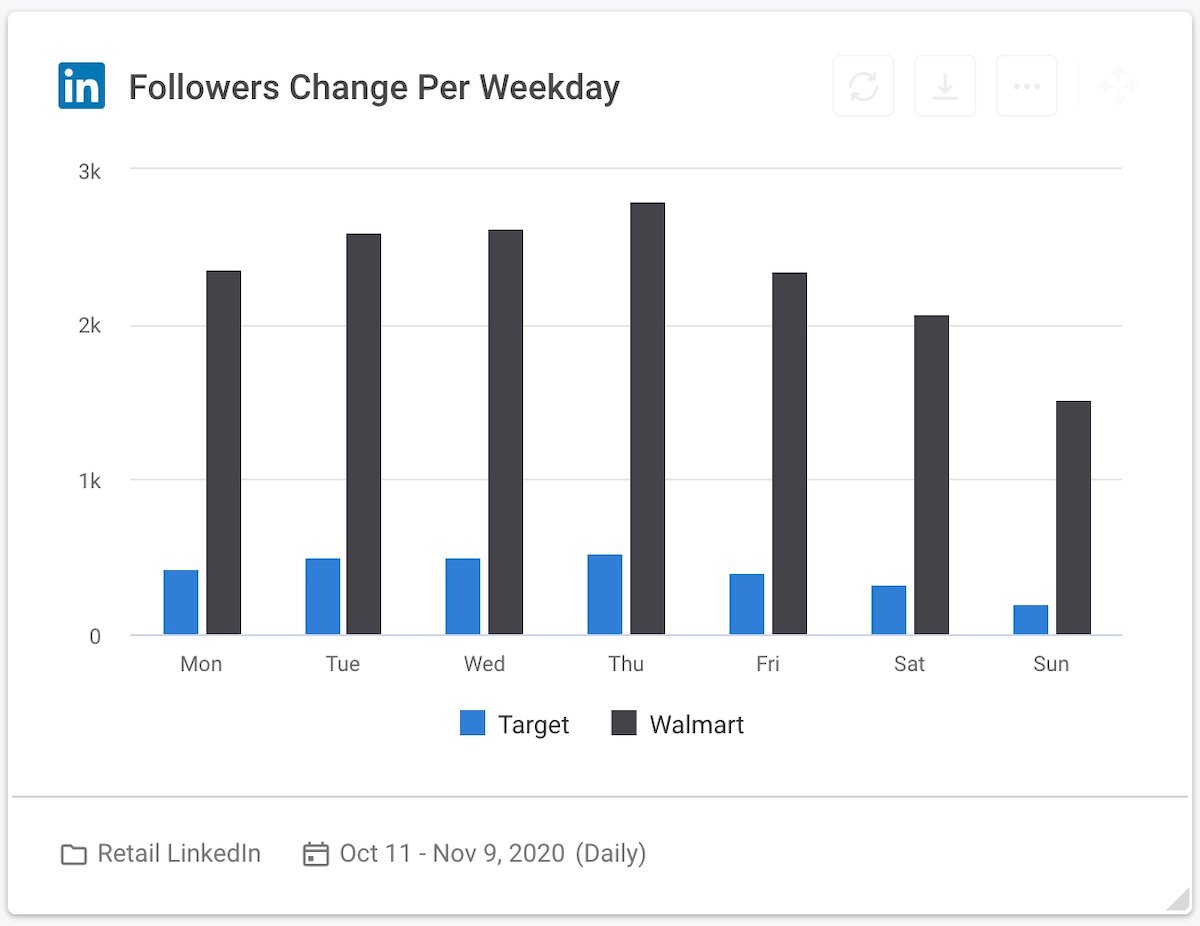
A social media competitive analysis tool made for agencies
Running a social media competitive analysis without the help of analytics tools is ineffective. That’s especially true for agencies juggling multiple client accounts.
There are plenty of analytics tools out there that help marketing agencies run a competitive analysis for their clients. However, quintly is unrivaled in terms of the depth of data you can track and analyze.
Here’s how quintly helps you:
- See all your clients’ data side by side with competitors, so it’s easy to analyze and compare.
- Save time yourself time and effort. When you set up metrics to track for your clients and competitors in quintly, data is collected automatically and converted to a standardized format.
- Get super specific about what you want to track using custom metrics and dashboards.
- Simplify the reporting process by creating attractive, straightforward competitor analysis reports at the click of a button that can be exported into multiple formats, including an interactive link.
Find out how you can run your social media competitive analysis with quintly that's been designed especially for marketing agencies.
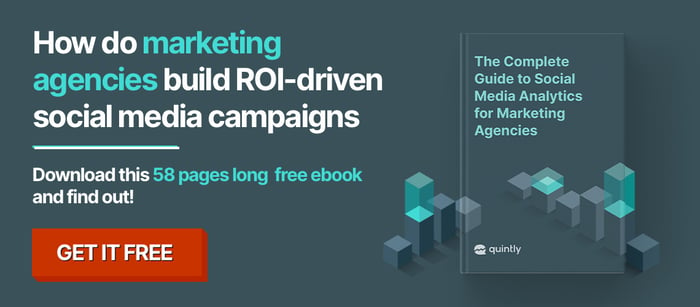
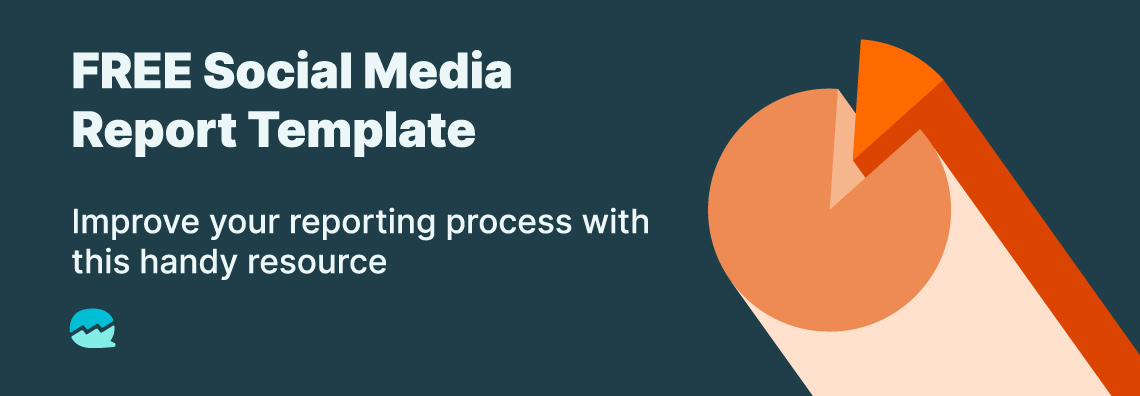

Join the conversation. Leave us a comment below!